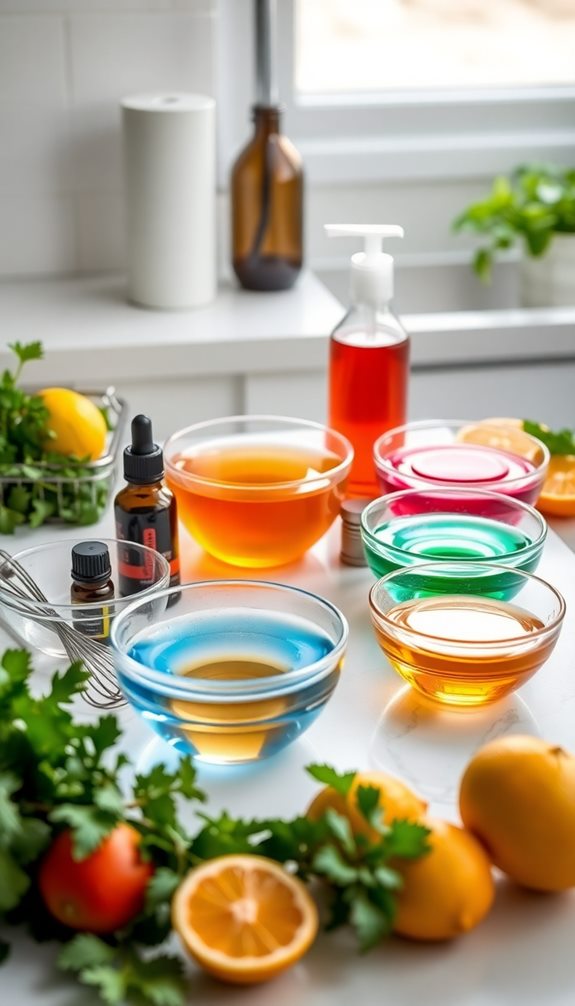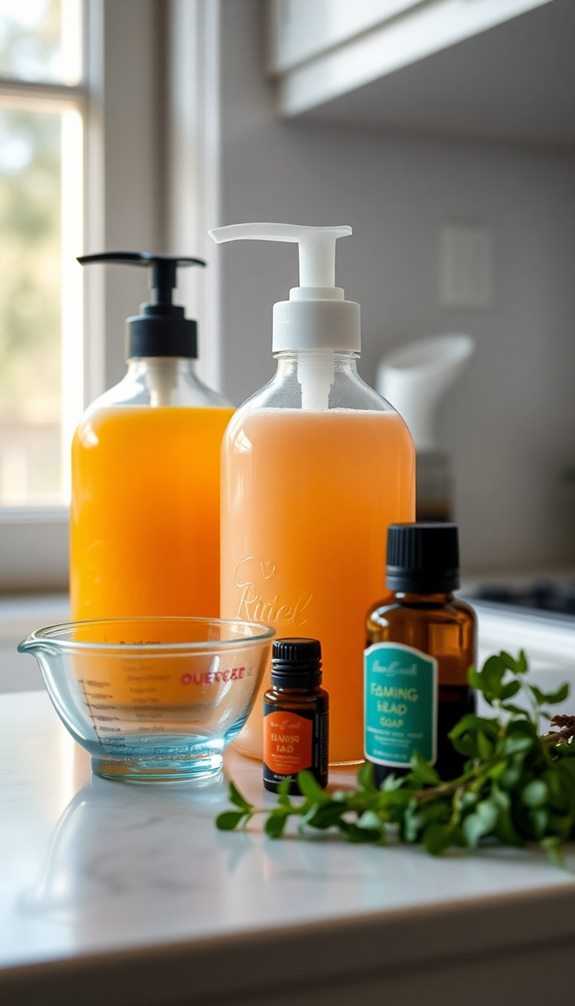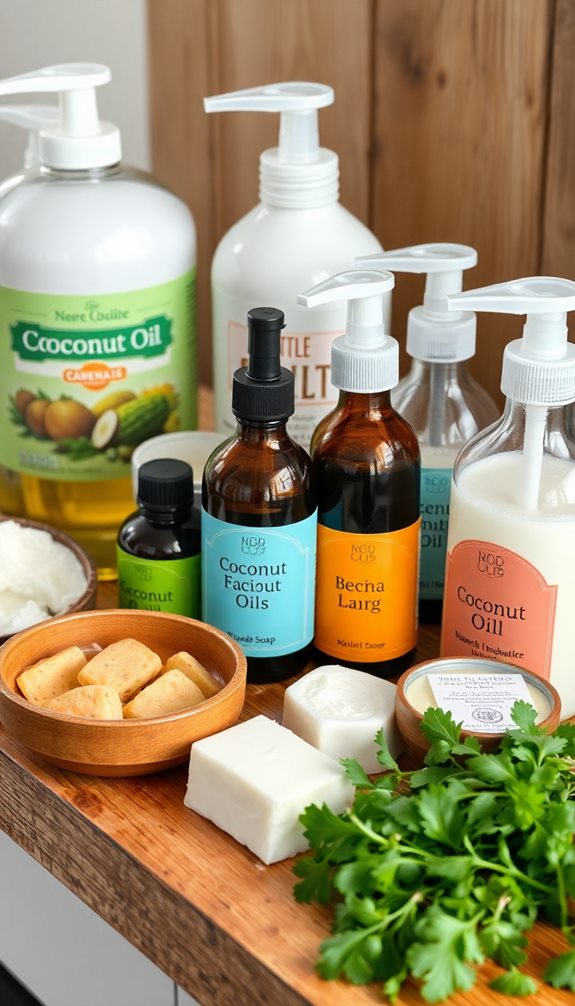Making foaming hand soap at home is simple and tailored for every skin type. Start with a mix of 1/3 cup liquid Castile soap and 2/3 cup distilled water. You can add 10-20 drops of essential oils for fragrance and skin benefits. For dry skin, consider adding moisturizing oils like jojoba or argan. If you have sensitive skin, opt for unscented varieties with soothing oils like chamomile. Remember to use a foaming dispenser and store your soap in a cool, dry place. There's much more to learn about customization and safety tips, so keep exploring your DIY options!
Benefits of DIY Foaming Hand Soap
DIY foaming hand soap offers numerous benefits that can enhance your daily routine. First off, it's a cost-effective solution that allows you to create about 22 containers of soap from just one bottle of liquid Castile soap. This greatly cuts down on household expenses while still providing a high-quality product.
Plus, by opting for a natural foaming hand soap, you eliminate synthetic chemicals and fragrances, making it perfect for those with sensitive skin. Additionally, using eco-friendly ingredients aligns with sustainable practices that help reduce environmental harm.
Another key advantage is the customizable option. You can choose your favorite essential oils and tailor the ingredients to meet your specific skin needs. This personal touch not only makes washing your hands more enjoyable but also guarantees that the soap works well for you.
Additionally, homemade foaming hand soap is environmentally friendly, utilizing biodegradable ingredients that help reduce plastic waste through refillable dispensers. The moisturizing properties, especially when you include vegetable glycerin and essential oils, prevent dryness and irritation, making it suitable for various skin types.
Essential Ingredients for Your Soap
When making your own foaming hand soap, you'll want to focus on a few key ingredients.
Start with liquid Castile soap as your base, then consider adding optional ingredients like essential oils for fragrance or vegetable glycerin for extra moisture.
Incorporating natural ingredients, such as baking soda for its gentle cleansing properties, can enhance the effectiveness of your soap.
Understanding these components will help you create a soap that's both effective and enjoyable to use.
Key Soap Ingredients
Essential ingredients play an important role in crafting effective foaming hand soap. When making your DIY foaming soap, focus on these key components to guarantee a gentle and effective formula:
- Liquid Castile soap: This serves as your primary cleansing agent, offering a biodegradable and gentle alternative free from harmful chemicals.
- Distilled water: Use this for dilution to keep your soap clean and prevent bacterial growth.
- Essential oils: Add these for fragrance and enhanced antibacterial properties. Popular choices include lemon, lavender, and peppermint, which also allow for customization.
- Vegetable glycerin: Incorporate this to boost moisture retention and improve texture, but be cautious as too much can create a sticky feel.
When combining these ingredients, remember the typical soap ratio: 1 part soap to 4 parts water. This guarantees ideal foaming action when dispensed, making your foaming hand soap not just effective but also enjoyable to use.
With these essential ingredients, you'll create a moisturizing and antibacterial hand soap that suits your skin type perfectly!
Optional Additives Explained
To enhance your foaming hand soap, consider adding optional ingredients that can elevate both its effectiveness and user experience.
Start with Liquid Castile Soap, a biodegradable base that's gentle enough for all skin types, including sensitive skin. Mixing in Distilled Water not only prevents bacterial growth but also extends your soap's shelf life, making it safer for daily use.
Next, think about incorporating Essential Oils for their therapeutic benefits and delightful scents. For example, lavender offers calming effects, lemon provides antibacterial properties, and tea tree oil boasts antifungal qualities. These oils can transform your DIY soap into a multi-functional product.
Don't forget to add Vegetable Glycerin. This ingredient is moisturizing, ensuring your hands stay soft and hydrated. It also improves the soap's texture for a smoother application.
If you want to add a splash of color, consider skin-safe colorants, but use them sparingly to avoid irritation.
Step-by-Step Soap Making

Creating your own foaming hand soap is a straightforward process that requires just a few simple ingredients and steps.
You'll love how easy it's to mix up a batch of homemade foaming soap that not only cleans but also moisturizes your hands. By using natural ingredients, you can guarantee a non-toxic cleaning solution that's gentle on your skin and free from harsh chemicals, making it a safer choice for your family's health and well-being.
Incorporating non-toxic cleaning practices can also enhance your overall hygiene routine.
Here's what you need to do:
- Gather your ingredients: 1/3 cup of liquid Castile soap, 2/3 cup of filtered water, and optional 1/8 teaspoon of essential oil for added fragrance and antibacterial properties.
- In a container, mix the liquid Castile soap and essential oil together. Slowly add the filtered water to prevent excessive foaming.
- Carefully transfer the mixture into a clean foaming soap dispenser, leaving some space for the pump to operate efficiently.
- Before each use, shake the dispenser gently to guarantee the ingredients are well combined, as natural separation may occur over time.
Store your foaming hand soap in a cool, dry place, and remember to use it within a few weeks if made with distilled water.
This DIY approach not only enhances your hand washing routine but also provides a delightful, fragrant experience!
Customization Options for All Skin Types
You can easily customize your foaming hand soap to suit your skin type by selecting specific ingredients and scents.
For sensitive skin, consider using unscented options and adding soothing essential oils, while those with oily skin might benefit from antibacterial additions like tea tree oil.
Incorporating natural cleaning agents such as vinegar and water solution can further enhance the effectiveness of your soap.
Adjusting the soap-to-water ratio also lets you achieve your preferred consistency, making your soap perfect for your needs.
Skin-Specific Ingredients
Finding the right ingredients for your foaming hand soap can make all the difference for your skin type. By customizing your soap, you can address specific skin concerns effectively. Here are some tailored suggestions:
- Sensitive Skin: Use unscented liquid Castile soap, mix it with distilled water, and add soothing essential oils like chamomile or lavender.
- Dry Skin: Incorporate moisturizing oils such as jojoba or argan oil to boost hydration and prevent irritation.
- Oily or Acne-Prone Skin: Add essential oils like tea tree or lemon, known for their antibacterial properties, to combat excess oil.
- Normal Skin: Create a balanced mixture of liquid Castile soap with a few drops of your favorite essential oil, like citrus or eucalyptus, for an effective cleanse.
If you're dealing with aging skin, consider adding vitamin E oil to your mixture.
It's renowned for its antioxidant properties and helps maintain skin elasticity and moisture.
Tailoring your foaming hand soap with these skin-specific ingredients guarantees that you're taking care of your skin while enjoying a delightful cleansing experience.
Scent Personalization Techniques
While customizing your foaming hand soap, scent personalization techniques can elevate your experience and cater to your skin's needs. Start by selecting essential oils that provide specific skin benefits. For instance, lavender is calming, tea tree oil boasts antibacterial properties, and lemon brightens the skin while offering a rejuvenating scent.
Next, play with custom scent ratios to find your perfect fragrance strength. Aim for 10-20 drops of essential oils in your DIY hand soap to avoid overwhelming aromas. If you have drier skin, incorporate carrier oils like jojoba or argan oil for added moisturizing properties. Just verify the total oil content remains balanced for effective cleansing.
Don't forget about color customization! Adding skin-safe colorants can enhance the aesthetic appeal of your soap without harming your skin. You can also experiment with seasonal scents, such as peppermint in winter or citrus oils during summer, to keep your hand soap fresh and suitable for various skin sensitivities throughout the year.
Tips for Safe Usage

Safety is paramount when using DIY foaming hand soap, especially if essential oils are involved. To guarantee safe usage, keep these tips in mind: Regularly cleaning the dispenser can help prevent contamination and maintain hygiene, similar to how effective DIY methods suggest maintaining plumbing health to prevent clogs.
- Conduct a Patch Test: Always test essential oils on a small area of skin first. This helps identify any potential skin reactions before using the soap on your hands extensively.
- Keep Out of Reach of Children: Store your foaming hand soap safely to prevent accidental ingestion or misuse by kids.
- Avoid Eye Contact: If soap gets in your eyes, rinse them thoroughly with water to prevent irritation.
- Store Properly: Keep your soap in a cool, dry place in a clean dispenser. Using glass or BPA-free plastic will help maintain soap quality and extend its shelf life.
Additionally, regularly clean the dispenser to avoid buildup and guarantee peak performance.
If you notice any separation or unusual odor, it's best to discard the soap.
Common Mistakes to Avoid
Many people make simple mistakes when creating DIY foaming hand soap that can affect its quality and safety. One common error is using tap water instead of distilled or boiled water. This can introduce bacteria, reducing your soap's shelf life.
Properly disinfecting your workspace and tools is also vital to prevent contamination and maintain cleanliness, which is important for overall health and hygiene maintains a clean and hygienic bathing environment.
Another mistake is overusing essential oils—stick to 10-20 drops per batch to prevent skin irritation.
Cleaning your foaming hand soap dispenser is also important; neglecting this step can lead to contamination and compromise your soap's quality.
Additionally, maintaining the correct soap-to-water ratio is vital. Aim for 1 part soap to 3 parts water to guarantee your homemade foaming hand soap is neither too thick nor too watery.
Lastly, don't skip the patch test for essential oils, especially if you have sensitive skin. Testing a small area first can help you avoid allergic reactions.
Recommended Resources and Products

When you're ready to create your DIY foaming hand soap, having the right resources and products on hand makes all the difference. Start with these essentials for an effective recipe: Eco-friendly options can also enhance your cleaning routine by incorporating natural ingredients that are gentle on the skin and the environment.
Consider using eco-friendly products to promote sustainability while crafting your soap.
- Dr. Bronners Liquid Soap: This popular choice is made from natural ingredients and can yield about 22 containers of foaming soap from just one 32-ounce bottle.
- Essential Oils: Customize your soap with scents like lemon, lavender, or tea tree. You'll need about 10-20 drops per batch for that perfect aroma and antibacterial benefits.
- Distilled Water: Always use distilled or boiled water to prevent bacterial growth, prolonging your soap's shelf life.
- Foaming Dispenser: You can easily find these at retailers like Target, Walmart, or Amazon. Alternatively, repurpose old soap containers to make your own foaming dispenser and promote eco-friendly practices.
Conclusion
Making your own foaming hand soap is not just fun; it's a great way to guarantee you're using gentle ingredients that suit your skin. Did you know that, on average, people wash their hands about 10 times a day? That means you can transform your hand-washing routine into a delightful experience tailored just for you. So go ahead, gather your supplies, and create a foaming soap that keeps your hands clean, soft, and happy!